Strategic HRM Interventions and Employee Engagement at IKEA
VerifiedAdded on 2020/01/21
|12
|4291
|56
Report
AI Summary
This report provides a comprehensive analysis of IKEA's human resource management (HRM) practices and their impact on employee engagement. It begins with an introduction to the significance of HRM in strategic management, emphasizing the role of human capital in achieving a competitive edge. The report then presents a company profile of IKEA, highlighting its global presence and innovative business model. The core of the report focuses on employee engagement, exploring flexible working practices, leadership development, and their influence on employee satisfaction and productivity. The report details IKEA's flexible working policies, including flexible schedules, job sharing, and telecommuting, as well as leadership development initiatives. It also examines the importance of employee engagement and various strategies IKEA employs to promote it, such as generous benefits, tuition reimbursement, and a focus on work-life balance. The report concludes by reflecting on the key takeaways and implications of IKEA's HRM approach.
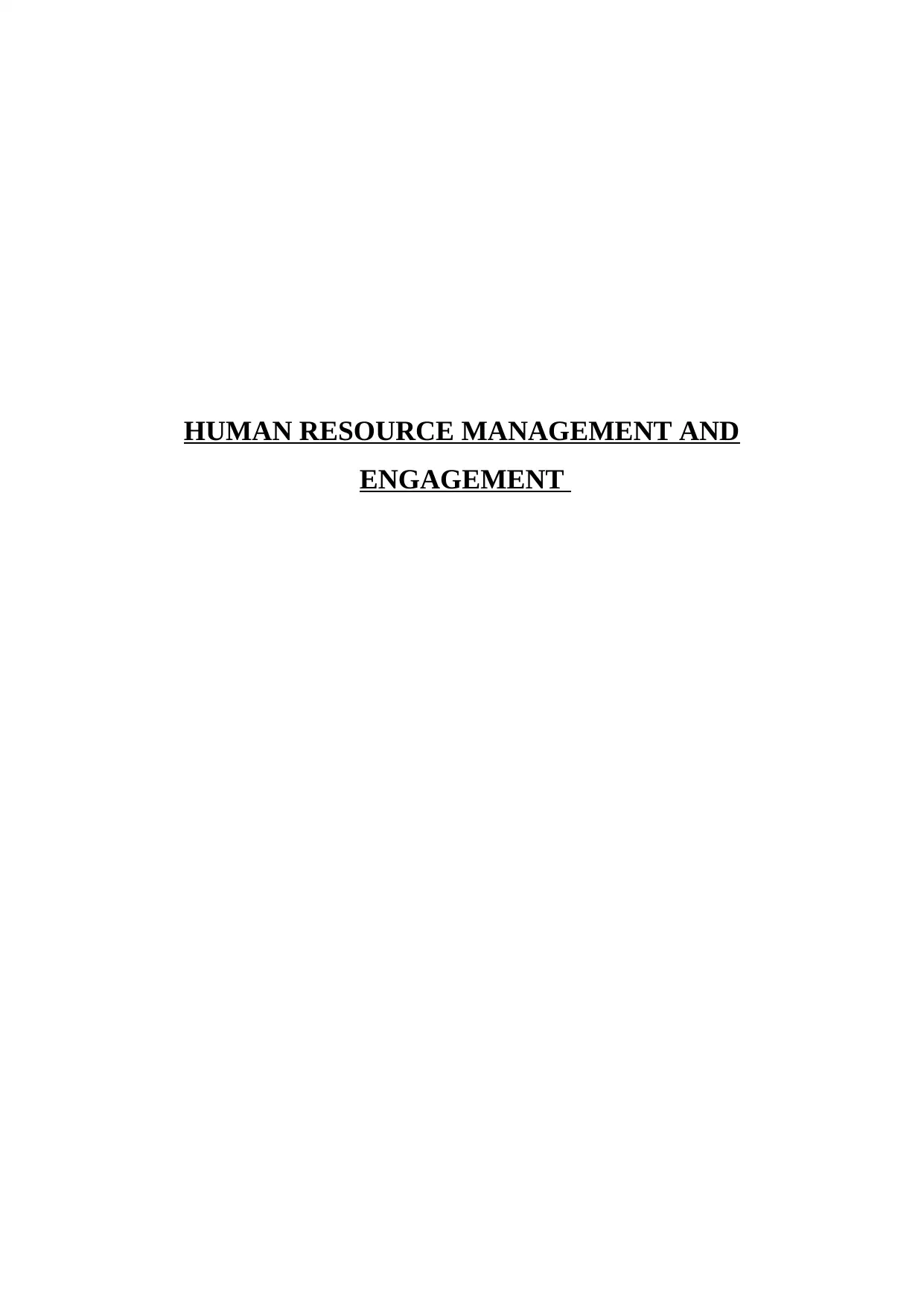
HUMAN RESOURCE MANAGEMENT AND
ENGAGEMENT
ENGAGEMENT
Paraphrase This Document
Need a fresh take? Get an instant paraphrase of this document with our AI Paraphraser
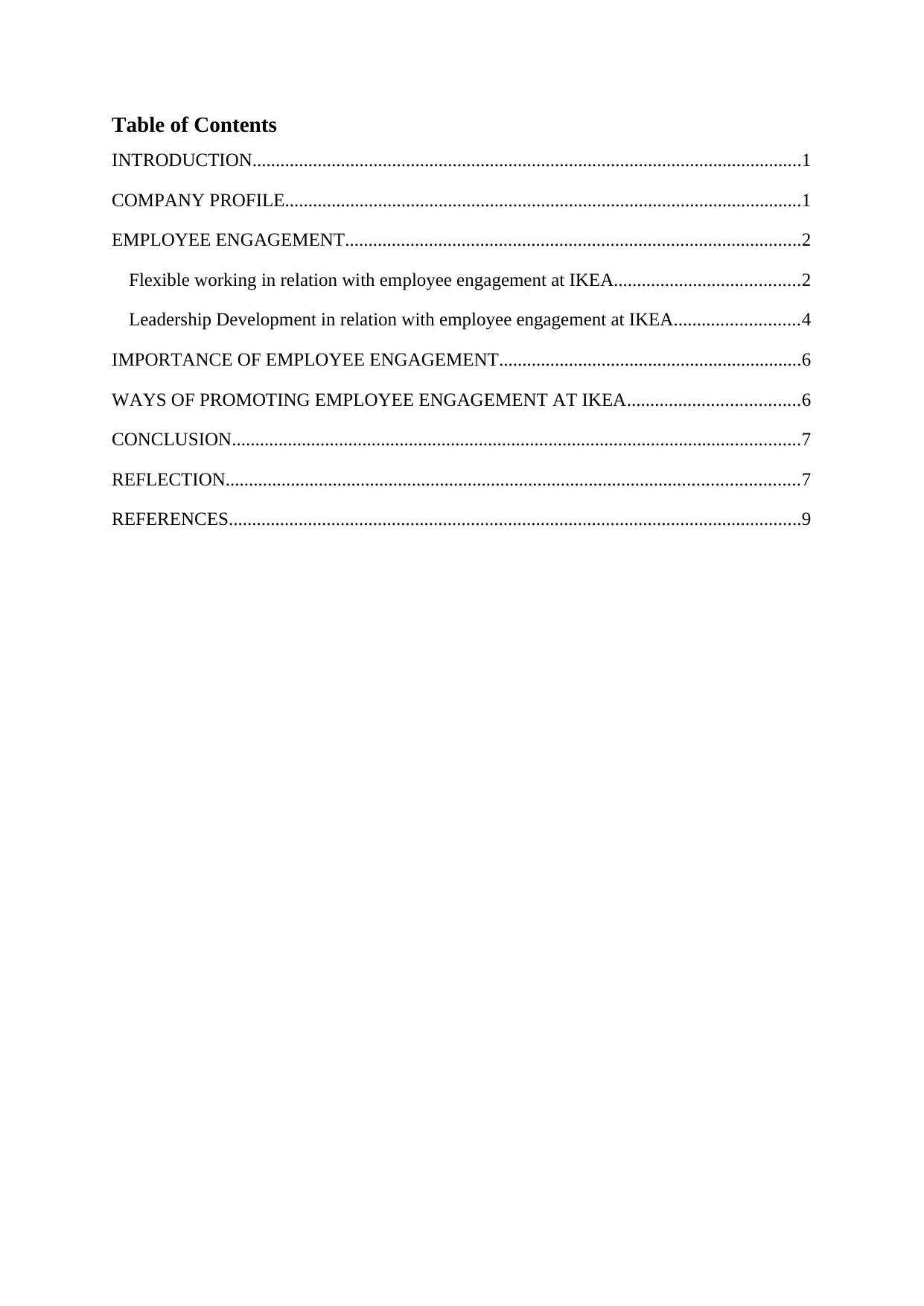
Table of Contents
INTRODUCTION......................................................................................................................1
COMPANY PROFILE...............................................................................................................1
EMPLOYEE ENGAGEMENT..................................................................................................2
Flexible working in relation with employee engagement at IKEA........................................2
Leadership Development in relation with employee engagement at IKEA...........................4
IMPORTANCE OF EMPLOYEE ENGAGEMENT.................................................................6
WAYS OF PROMOTING EMPLOYEE ENGAGEMENT AT IKEA.....................................6
CONCLUSION..........................................................................................................................7
REFLECTION...........................................................................................................................7
REFERENCES...........................................................................................................................9
INTRODUCTION......................................................................................................................1
COMPANY PROFILE...............................................................................................................1
EMPLOYEE ENGAGEMENT..................................................................................................2
Flexible working in relation with employee engagement at IKEA........................................2
Leadership Development in relation with employee engagement at IKEA...........................4
IMPORTANCE OF EMPLOYEE ENGAGEMENT.................................................................6
WAYS OF PROMOTING EMPLOYEE ENGAGEMENT AT IKEA.....................................6
CONCLUSION..........................................................................................................................7
REFLECTION...........................................................................................................................7
REFERENCES...........................................................................................................................9
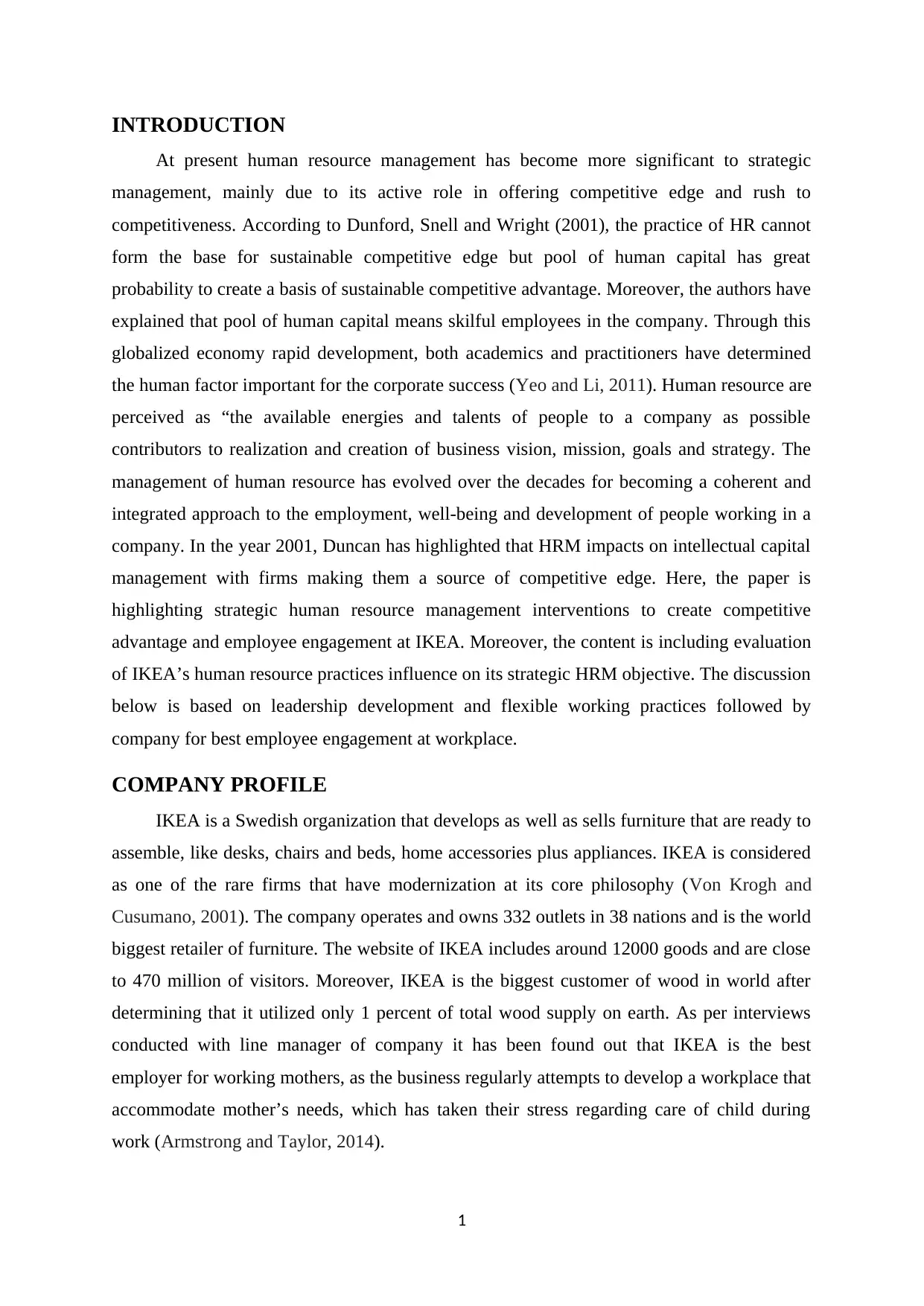
INTRODUCTION
At present human resource management has become more significant to strategic
management, mainly due to its active role in offering competitive edge and rush to
competitiveness. According to Dunford, Snell and Wright (2001), the practice of HR cannot
form the base for sustainable competitive edge but pool of human capital has great
probability to create a basis of sustainable competitive advantage. Moreover, the authors have
explained that pool of human capital means skilful employees in the company. Through this
globalized economy rapid development, both academics and practitioners have determined
the human factor important for the corporate success (Yeo and Li, 2011). Human resource are
perceived as “the available energies and talents of people to a company as possible
contributors to realization and creation of business vision, mission, goals and strategy. The
management of human resource has evolved over the decades for becoming a coherent and
integrated approach to the employment, well-being and development of people working in a
company. In the year 2001, Duncan has highlighted that HRM impacts on intellectual capital
management with firms making them a source of competitive edge. Here, the paper is
highlighting strategic human resource management interventions to create competitive
advantage and employee engagement at IKEA. Moreover, the content is including evaluation
of IKEA’s human resource practices influence on its strategic HRM objective. The discussion
below is based on leadership development and flexible working practices followed by
company for best employee engagement at workplace.
COMPANY PROFILE
IKEA is a Swedish organization that develops as well as sells furniture that are ready to
assemble, like desks, chairs and beds, home accessories plus appliances. IKEA is considered
as one of the rare firms that have modernization at its core philosophy (Von Krogh and
Cusumano, 2001). The company operates and owns 332 outlets in 38 nations and is the world
biggest retailer of furniture. The website of IKEA includes around 12000 goods and are close
to 470 million of visitors. Moreover, IKEA is the biggest customer of wood in world after
determining that it utilized only 1 percent of total wood supply on earth. As per interviews
conducted with line manager of company it has been found out that IKEA is the best
employer for working mothers, as the business regularly attempts to develop a workplace that
accommodate mother’s needs, which has taken their stress regarding care of child during
work (Armstrong and Taylor, 2014).
1
At present human resource management has become more significant to strategic
management, mainly due to its active role in offering competitive edge and rush to
competitiveness. According to Dunford, Snell and Wright (2001), the practice of HR cannot
form the base for sustainable competitive edge but pool of human capital has great
probability to create a basis of sustainable competitive advantage. Moreover, the authors have
explained that pool of human capital means skilful employees in the company. Through this
globalized economy rapid development, both academics and practitioners have determined
the human factor important for the corporate success (Yeo and Li, 2011). Human resource are
perceived as “the available energies and talents of people to a company as possible
contributors to realization and creation of business vision, mission, goals and strategy. The
management of human resource has evolved over the decades for becoming a coherent and
integrated approach to the employment, well-being and development of people working in a
company. In the year 2001, Duncan has highlighted that HRM impacts on intellectual capital
management with firms making them a source of competitive edge. Here, the paper is
highlighting strategic human resource management interventions to create competitive
advantage and employee engagement at IKEA. Moreover, the content is including evaluation
of IKEA’s human resource practices influence on its strategic HRM objective. The discussion
below is based on leadership development and flexible working practices followed by
company for best employee engagement at workplace.
COMPANY PROFILE
IKEA is a Swedish organization that develops as well as sells furniture that are ready to
assemble, like desks, chairs and beds, home accessories plus appliances. IKEA is considered
as one of the rare firms that have modernization at its core philosophy (Von Krogh and
Cusumano, 2001). The company operates and owns 332 outlets in 38 nations and is the world
biggest retailer of furniture. The website of IKEA includes around 12000 goods and are close
to 470 million of visitors. Moreover, IKEA is the biggest customer of wood in world after
determining that it utilized only 1 percent of total wood supply on earth. As per interviews
conducted with line manager of company it has been found out that IKEA is the best
employer for working mothers, as the business regularly attempts to develop a workplace that
accommodate mother’s needs, which has taken their stress regarding care of child during
work (Armstrong and Taylor, 2014).
1
⊘ This is a preview!⊘
Do you want full access?
Subscribe today to unlock all pages.

Trusted by 1+ million students worldwide
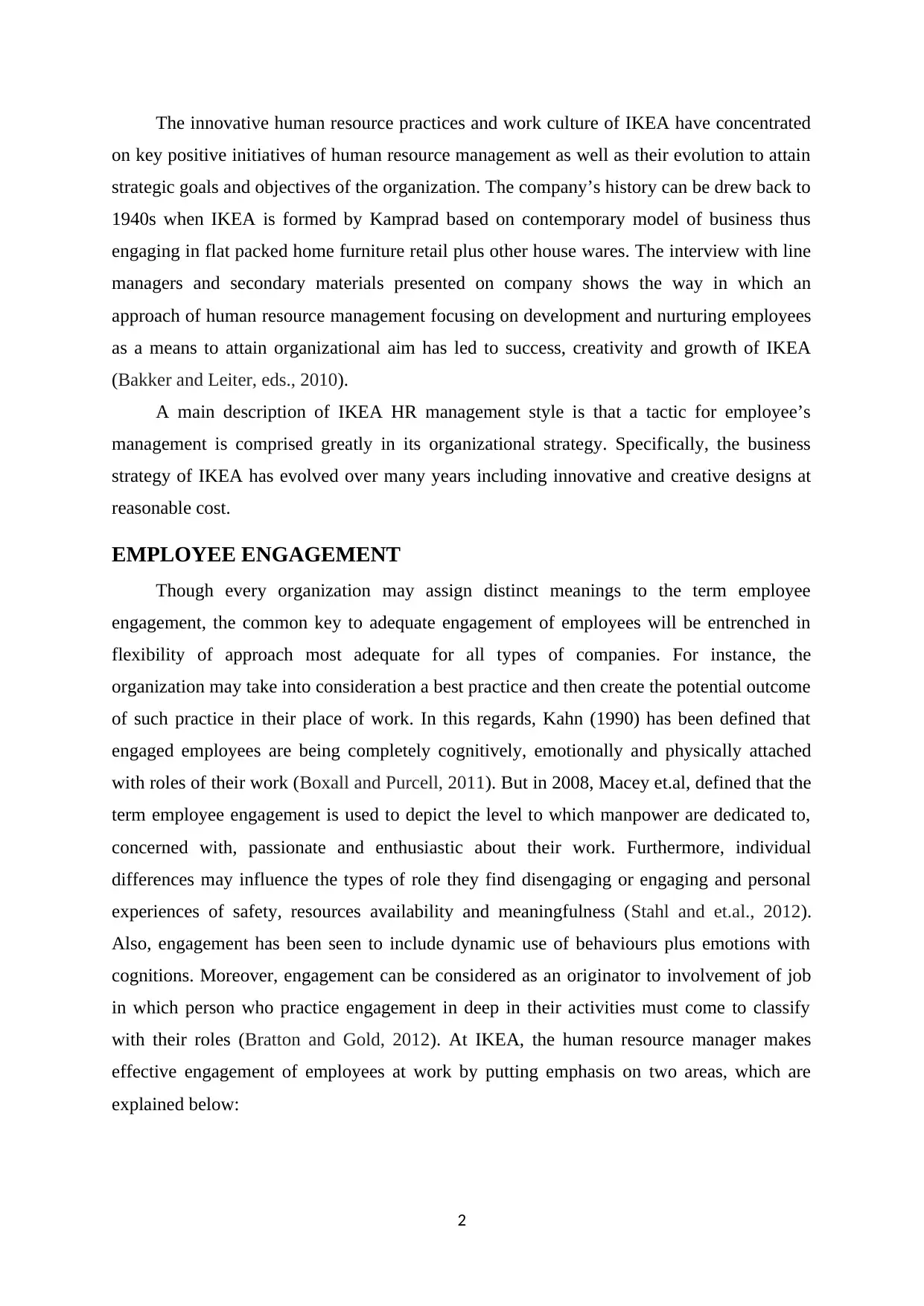
The innovative human resource practices and work culture of IKEA have concentrated
on key positive initiatives of human resource management as well as their evolution to attain
strategic goals and objectives of the organization. The company’s history can be drew back to
1940s when IKEA is formed by Kamprad based on contemporary model of business thus
engaging in flat packed home furniture retail plus other house wares. The interview with line
managers and secondary materials presented on company shows the way in which an
approach of human resource management focusing on development and nurturing employees
as a means to attain organizational aim has led to success, creativity and growth of IKEA
(Bakker and Leiter, eds., 2010).
A main description of IKEA HR management style is that a tactic for employee’s
management is comprised greatly in its organizational strategy. Specifically, the business
strategy of IKEA has evolved over many years including innovative and creative designs at
reasonable cost.
EMPLOYEE ENGAGEMENT
Though every organization may assign distinct meanings to the term employee
engagement, the common key to adequate engagement of employees will be entrenched in
flexibility of approach most adequate for all types of companies. For instance, the
organization may take into consideration a best practice and then create the potential outcome
of such practice in their place of work. In this regards, Kahn (1990) has been defined that
engaged employees are being completely cognitively, emotionally and physically attached
with roles of their work (Boxall and Purcell, 2011). But in 2008, Macey et.al, defined that the
term employee engagement is used to depict the level to which manpower are dedicated to,
concerned with, passionate and enthusiastic about their work. Furthermore, individual
differences may influence the types of role they find disengaging or engaging and personal
experiences of safety, resources availability and meaningfulness (Stahl and et.al., 2012).
Also, engagement has been seen to include dynamic use of behaviours plus emotions with
cognitions. Moreover, engagement can be considered as an originator to involvement of job
in which person who practice engagement in deep in their activities must come to classify
with their roles (Bratton and Gold, 2012). At IKEA, the human resource manager makes
effective engagement of employees at work by putting emphasis on two areas, which are
explained below:
2
on key positive initiatives of human resource management as well as their evolution to attain
strategic goals and objectives of the organization. The company’s history can be drew back to
1940s when IKEA is formed by Kamprad based on contemporary model of business thus
engaging in flat packed home furniture retail plus other house wares. The interview with line
managers and secondary materials presented on company shows the way in which an
approach of human resource management focusing on development and nurturing employees
as a means to attain organizational aim has led to success, creativity and growth of IKEA
(Bakker and Leiter, eds., 2010).
A main description of IKEA HR management style is that a tactic for employee’s
management is comprised greatly in its organizational strategy. Specifically, the business
strategy of IKEA has evolved over many years including innovative and creative designs at
reasonable cost.
EMPLOYEE ENGAGEMENT
Though every organization may assign distinct meanings to the term employee
engagement, the common key to adequate engagement of employees will be entrenched in
flexibility of approach most adequate for all types of companies. For instance, the
organization may take into consideration a best practice and then create the potential outcome
of such practice in their place of work. In this regards, Kahn (1990) has been defined that
engaged employees are being completely cognitively, emotionally and physically attached
with roles of their work (Boxall and Purcell, 2011). But in 2008, Macey et.al, defined that the
term employee engagement is used to depict the level to which manpower are dedicated to,
concerned with, passionate and enthusiastic about their work. Furthermore, individual
differences may influence the types of role they find disengaging or engaging and personal
experiences of safety, resources availability and meaningfulness (Stahl and et.al., 2012).
Also, engagement has been seen to include dynamic use of behaviours plus emotions with
cognitions. Moreover, engagement can be considered as an originator to involvement of job
in which person who practice engagement in deep in their activities must come to classify
with their roles (Bratton and Gold, 2012). At IKEA, the human resource manager makes
effective engagement of employees at work by putting emphasis on two areas, which are
explained below:
2
Paraphrase This Document
Need a fresh take? Get an instant paraphrase of this document with our AI Paraphraser
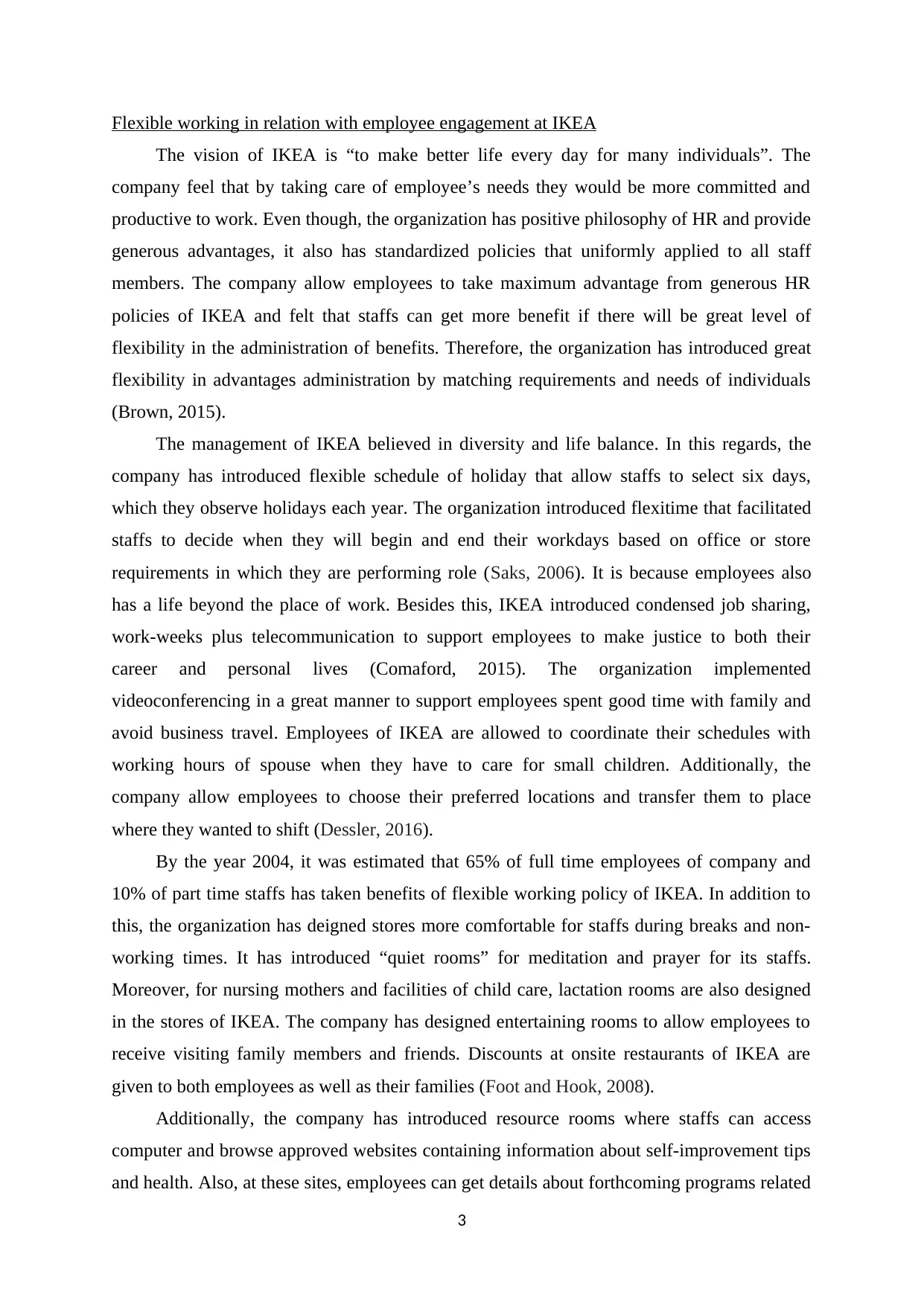
Flexible working in relation with employee engagement at IKEA
The vision of IKEA is “to make better life every day for many individuals”. The
company feel that by taking care of employee’s needs they would be more committed and
productive to work. Even though, the organization has positive philosophy of HR and provide
generous advantages, it also has standardized policies that uniformly applied to all staff
members. The company allow employees to take maximum advantage from generous HR
policies of IKEA and felt that staffs can get more benefit if there will be great level of
flexibility in the administration of benefits. Therefore, the organization has introduced great
flexibility in advantages administration by matching requirements and needs of individuals
(Brown, 2015).
The management of IKEA believed in diversity and life balance. In this regards, the
company has introduced flexible schedule of holiday that allow staffs to select six days,
which they observe holidays each year. The organization introduced flexitime that facilitated
staffs to decide when they will begin and end their workdays based on office or store
requirements in which they are performing role (Saks, 2006). It is because employees also
has a life beyond the place of work. Besides this, IKEA introduced condensed job sharing,
work-weeks plus telecommunication to support employees to make justice to both their
career and personal lives (Comaford, 2015). The organization implemented
videoconferencing in a great manner to support employees spent good time with family and
avoid business travel. Employees of IKEA are allowed to coordinate their schedules with
working hours of spouse when they have to care for small children. Additionally, the
company allow employees to choose their preferred locations and transfer them to place
where they wanted to shift (Dessler, 2016).
By the year 2004, it was estimated that 65% of full time employees of company and
10% of part time staffs has taken benefits of flexible working policy of IKEA. In addition to
this, the organization has deigned stores more comfortable for staffs during breaks and non-
working times. It has introduced “quiet rooms” for meditation and prayer for its staffs.
Moreover, for nursing mothers and facilities of child care, lactation rooms are also designed
in the stores of IKEA. The company has designed entertaining rooms to allow employees to
receive visiting family members and friends. Discounts at onsite restaurants of IKEA are
given to both employees as well as their families (Foot and Hook, 2008).
Additionally, the company has introduced resource rooms where staffs can access
computer and browse approved websites containing information about self-improvement tips
and health. Also, at these sites, employees can get details about forthcoming programs related
3
The vision of IKEA is “to make better life every day for many individuals”. The
company feel that by taking care of employee’s needs they would be more committed and
productive to work. Even though, the organization has positive philosophy of HR and provide
generous advantages, it also has standardized policies that uniformly applied to all staff
members. The company allow employees to take maximum advantage from generous HR
policies of IKEA and felt that staffs can get more benefit if there will be great level of
flexibility in the administration of benefits. Therefore, the organization has introduced great
flexibility in advantages administration by matching requirements and needs of individuals
(Brown, 2015).
The management of IKEA believed in diversity and life balance. In this regards, the
company has introduced flexible schedule of holiday that allow staffs to select six days,
which they observe holidays each year. The organization introduced flexitime that facilitated
staffs to decide when they will begin and end their workdays based on office or store
requirements in which they are performing role (Saks, 2006). It is because employees also
has a life beyond the place of work. Besides this, IKEA introduced condensed job sharing,
work-weeks plus telecommunication to support employees to make justice to both their
career and personal lives (Comaford, 2015). The organization implemented
videoconferencing in a great manner to support employees spent good time with family and
avoid business travel. Employees of IKEA are allowed to coordinate their schedules with
working hours of spouse when they have to care for small children. Additionally, the
company allow employees to choose their preferred locations and transfer them to place
where they wanted to shift (Dessler, 2016).
By the year 2004, it was estimated that 65% of full time employees of company and
10% of part time staffs has taken benefits of flexible working policy of IKEA. In addition to
this, the organization has deigned stores more comfortable for staffs during breaks and non-
working times. It has introduced “quiet rooms” for meditation and prayer for its staffs.
Moreover, for nursing mothers and facilities of child care, lactation rooms are also designed
in the stores of IKEA. The company has designed entertaining rooms to allow employees to
receive visiting family members and friends. Discounts at onsite restaurants of IKEA are
given to both employees as well as their families (Foot and Hook, 2008).
Additionally, the company has introduced resource rooms where staffs can access
computer and browse approved websites containing information about self-improvement tips
and health. Also, at these sites, employees can get details about forthcoming programs related
3
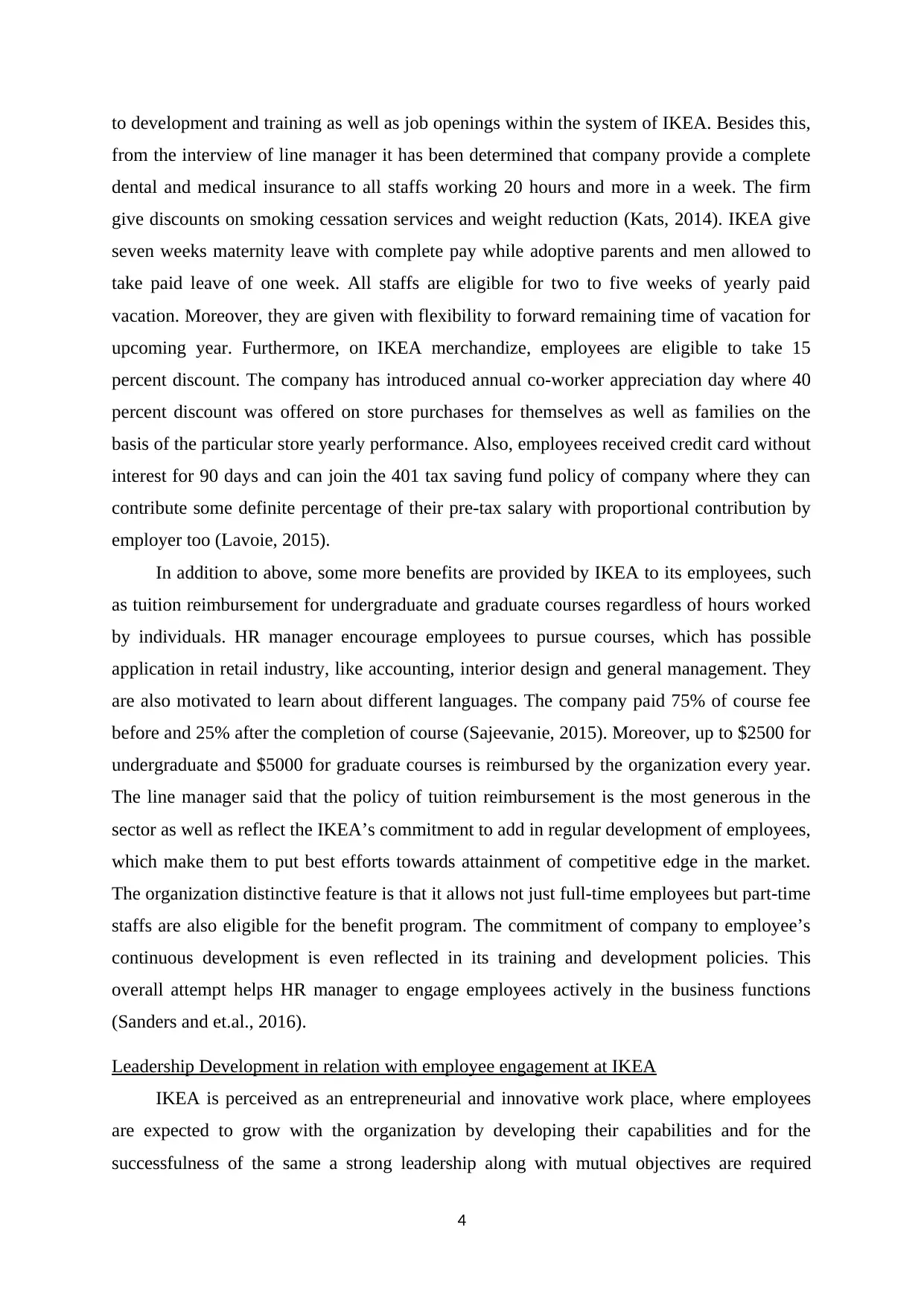
to development and training as well as job openings within the system of IKEA. Besides this,
from the interview of line manager it has been determined that company provide a complete
dental and medical insurance to all staffs working 20 hours and more in a week. The firm
give discounts on smoking cessation services and weight reduction (Kats, 2014). IKEA give
seven weeks maternity leave with complete pay while adoptive parents and men allowed to
take paid leave of one week. All staffs are eligible for two to five weeks of yearly paid
vacation. Moreover, they are given with flexibility to forward remaining time of vacation for
upcoming year. Furthermore, on IKEA merchandize, employees are eligible to take 15
percent discount. The company has introduced annual co-worker appreciation day where 40
percent discount was offered on store purchases for themselves as well as families on the
basis of the particular store yearly performance. Also, employees received credit card without
interest for 90 days and can join the 401 tax saving fund policy of company where they can
contribute some definite percentage of their pre-tax salary with proportional contribution by
employer too (Lavoie, 2015).
In addition to above, some more benefits are provided by IKEA to its employees, such
as tuition reimbursement for undergraduate and graduate courses regardless of hours worked
by individuals. HR manager encourage employees to pursue courses, which has possible
application in retail industry, like accounting, interior design and general management. They
are also motivated to learn about different languages. The company paid 75% of course fee
before and 25% after the completion of course (Sajeevanie, 2015). Moreover, up to $2500 for
undergraduate and $5000 for graduate courses is reimbursed by the organization every year.
The line manager said that the policy of tuition reimbursement is the most generous in the
sector as well as reflect the IKEA’s commitment to add in regular development of employees,
which make them to put best efforts towards attainment of competitive edge in the market.
The organization distinctive feature is that it allows not just full-time employees but part-time
staffs are also eligible for the benefit program. The commitment of company to employee’s
continuous development is even reflected in its training and development policies. This
overall attempt helps HR manager to engage employees actively in the business functions
(Sanders and et.al., 2016).
Leadership Development in relation with employee engagement at IKEA
IKEA is perceived as an entrepreneurial and innovative work place, where employees
are expected to grow with the organization by developing their capabilities and for the
successfulness of the same a strong leadership along with mutual objectives are required
4
from the interview of line manager it has been determined that company provide a complete
dental and medical insurance to all staffs working 20 hours and more in a week. The firm
give discounts on smoking cessation services and weight reduction (Kats, 2014). IKEA give
seven weeks maternity leave with complete pay while adoptive parents and men allowed to
take paid leave of one week. All staffs are eligible for two to five weeks of yearly paid
vacation. Moreover, they are given with flexibility to forward remaining time of vacation for
upcoming year. Furthermore, on IKEA merchandize, employees are eligible to take 15
percent discount. The company has introduced annual co-worker appreciation day where 40
percent discount was offered on store purchases for themselves as well as families on the
basis of the particular store yearly performance. Also, employees received credit card without
interest for 90 days and can join the 401 tax saving fund policy of company where they can
contribute some definite percentage of their pre-tax salary with proportional contribution by
employer too (Lavoie, 2015).
In addition to above, some more benefits are provided by IKEA to its employees, such
as tuition reimbursement for undergraduate and graduate courses regardless of hours worked
by individuals. HR manager encourage employees to pursue courses, which has possible
application in retail industry, like accounting, interior design and general management. They
are also motivated to learn about different languages. The company paid 75% of course fee
before and 25% after the completion of course (Sajeevanie, 2015). Moreover, up to $2500 for
undergraduate and $5000 for graduate courses is reimbursed by the organization every year.
The line manager said that the policy of tuition reimbursement is the most generous in the
sector as well as reflect the IKEA’s commitment to add in regular development of employees,
which make them to put best efforts towards attainment of competitive edge in the market.
The organization distinctive feature is that it allows not just full-time employees but part-time
staffs are also eligible for the benefit program. The commitment of company to employee’s
continuous development is even reflected in its training and development policies. This
overall attempt helps HR manager to engage employees actively in the business functions
(Sanders and et.al., 2016).
Leadership Development in relation with employee engagement at IKEA
IKEA is perceived as an entrepreneurial and innovative work place, where employees
are expected to grow with the organization by developing their capabilities and for the
successfulness of the same a strong leadership along with mutual objectives are required
4
⊘ This is a preview!⊘
Do you want full access?
Subscribe today to unlock all pages.

Trusted by 1+ million students worldwide
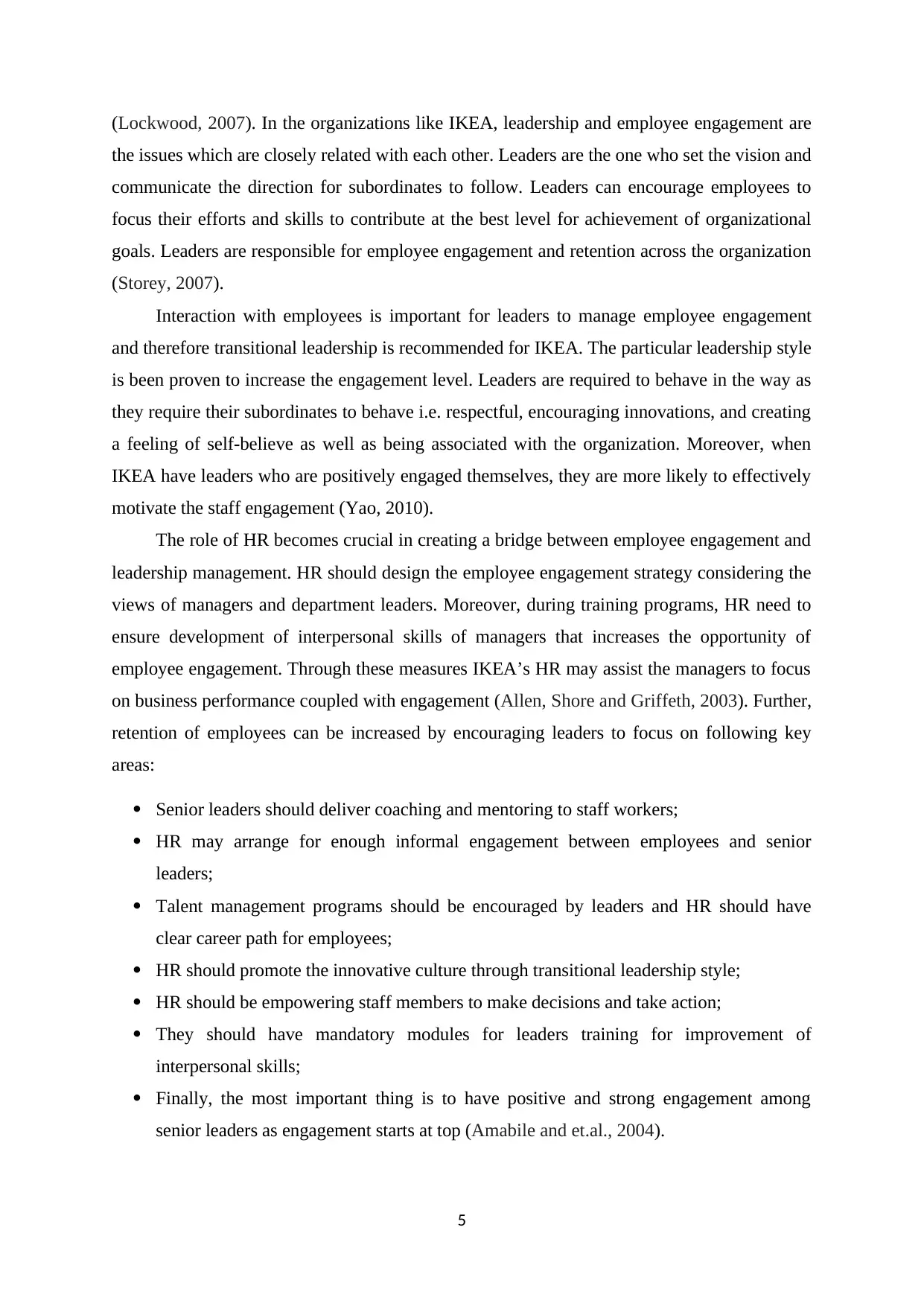
(Lockwood, 2007). In the organizations like IKEA, leadership and employee engagement are
the issues which are closely related with each other. Leaders are the one who set the vision and
communicate the direction for subordinates to follow. Leaders can encourage employees to
focus their efforts and skills to contribute at the best level for achievement of organizational
goals. Leaders are responsible for employee engagement and retention across the organization
(Storey, 2007).
Interaction with employees is important for leaders to manage employee engagement
and therefore transitional leadership is recommended for IKEA. The particular leadership style
is been proven to increase the engagement level. Leaders are required to behave in the way as
they require their subordinates to behave i.e. respectful, encouraging innovations, and creating
a feeling of self-believe as well as being associated with the organization. Moreover, when
IKEA have leaders who are positively engaged themselves, they are more likely to effectively
motivate the staff engagement (Yao, 2010).
The role of HR becomes crucial in creating a bridge between employee engagement and
leadership management. HR should design the employee engagement strategy considering the
views of managers and department leaders. Moreover, during training programs, HR need to
ensure development of interpersonal skills of managers that increases the opportunity of
employee engagement. Through these measures IKEA’s HR may assist the managers to focus
on business performance coupled with engagement (Allen, Shore and Griffeth, 2003). Further,
retention of employees can be increased by encouraging leaders to focus on following key
areas:
Senior leaders should deliver coaching and mentoring to staff workers;
HR may arrange for enough informal engagement between employees and senior
leaders;
Talent management programs should be encouraged by leaders and HR should have
clear career path for employees;
HR should promote the innovative culture through transitional leadership style;
HR should be empowering staff members to make decisions and take action;
They should have mandatory modules for leaders training for improvement of
interpersonal skills;
Finally, the most important thing is to have positive and strong engagement among
senior leaders as engagement starts at top (Amabile and et.al., 2004).
5
the issues which are closely related with each other. Leaders are the one who set the vision and
communicate the direction for subordinates to follow. Leaders can encourage employees to
focus their efforts and skills to contribute at the best level for achievement of organizational
goals. Leaders are responsible for employee engagement and retention across the organization
(Storey, 2007).
Interaction with employees is important for leaders to manage employee engagement
and therefore transitional leadership is recommended for IKEA. The particular leadership style
is been proven to increase the engagement level. Leaders are required to behave in the way as
they require their subordinates to behave i.e. respectful, encouraging innovations, and creating
a feeling of self-believe as well as being associated with the organization. Moreover, when
IKEA have leaders who are positively engaged themselves, they are more likely to effectively
motivate the staff engagement (Yao, 2010).
The role of HR becomes crucial in creating a bridge between employee engagement and
leadership management. HR should design the employee engagement strategy considering the
views of managers and department leaders. Moreover, during training programs, HR need to
ensure development of interpersonal skills of managers that increases the opportunity of
employee engagement. Through these measures IKEA’s HR may assist the managers to focus
on business performance coupled with engagement (Allen, Shore and Griffeth, 2003). Further,
retention of employees can be increased by encouraging leaders to focus on following key
areas:
Senior leaders should deliver coaching and mentoring to staff workers;
HR may arrange for enough informal engagement between employees and senior
leaders;
Talent management programs should be encouraged by leaders and HR should have
clear career path for employees;
HR should promote the innovative culture through transitional leadership style;
HR should be empowering staff members to make decisions and take action;
They should have mandatory modules for leaders training for improvement of
interpersonal skills;
Finally, the most important thing is to have positive and strong engagement among
senior leaders as engagement starts at top (Amabile and et.al., 2004).
5
Paraphrase This Document
Need a fresh take? Get an instant paraphrase of this document with our AI Paraphraser
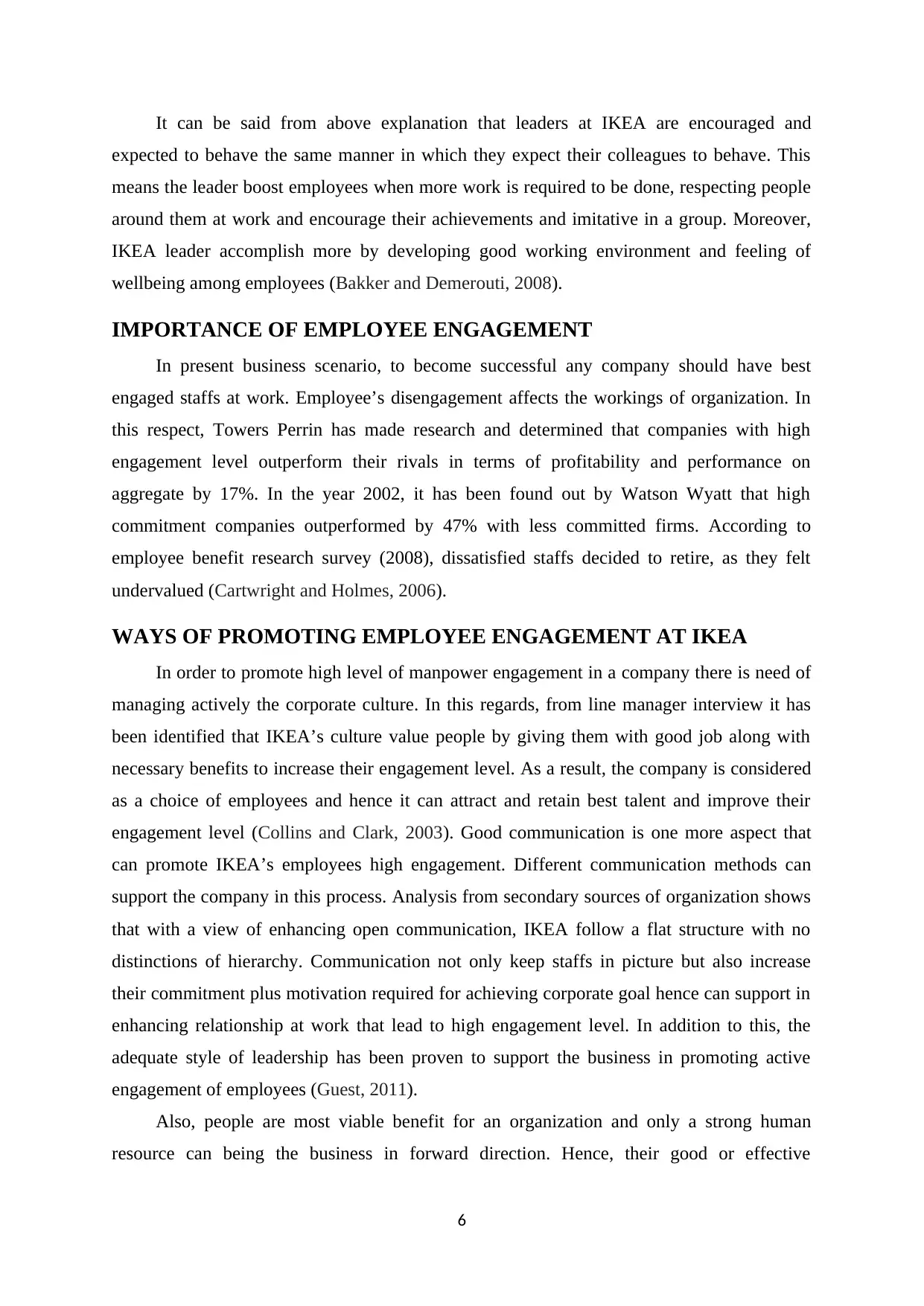
It can be said from above explanation that leaders at IKEA are encouraged and
expected to behave the same manner in which they expect their colleagues to behave. This
means the leader boost employees when more work is required to be done, respecting people
around them at work and encourage their achievements and imitative in a group. Moreover,
IKEA leader accomplish more by developing good working environment and feeling of
wellbeing among employees (Bakker and Demerouti, 2008).
IMPORTANCE OF EMPLOYEE ENGAGEMENT
In present business scenario, to become successful any company should have best
engaged staffs at work. Employee’s disengagement affects the workings of organization. In
this respect, Towers Perrin has made research and determined that companies with high
engagement level outperform their rivals in terms of profitability and performance on
aggregate by 17%. In the year 2002, it has been found out by Watson Wyatt that high
commitment companies outperformed by 47% with less committed firms. According to
employee benefit research survey (2008), dissatisfied staffs decided to retire, as they felt
undervalued (Cartwright and Holmes, 2006).
WAYS OF PROMOTING EMPLOYEE ENGAGEMENT AT IKEA
In order to promote high level of manpower engagement in a company there is need of
managing actively the corporate culture. In this regards, from line manager interview it has
been identified that IKEA’s culture value people by giving them with good job along with
necessary benefits to increase their engagement level. As a result, the company is considered
as a choice of employees and hence it can attract and retain best talent and improve their
engagement level (Collins and Clark, 2003). Good communication is one more aspect that
can promote IKEA’s employees high engagement. Different communication methods can
support the company in this process. Analysis from secondary sources of organization shows
that with a view of enhancing open communication, IKEA follow a flat structure with no
distinctions of hierarchy. Communication not only keep staffs in picture but also increase
their commitment plus motivation required for achieving corporate goal hence can support in
enhancing relationship at work that lead to high engagement level. In addition to this, the
adequate style of leadership has been proven to support the business in promoting active
engagement of employees (Guest, 2011).
Also, people are most viable benefit for an organization and only a strong human
resource can being the business in forward direction. Hence, their good or effective
6
expected to behave the same manner in which they expect their colleagues to behave. This
means the leader boost employees when more work is required to be done, respecting people
around them at work and encourage their achievements and imitative in a group. Moreover,
IKEA leader accomplish more by developing good working environment and feeling of
wellbeing among employees (Bakker and Demerouti, 2008).
IMPORTANCE OF EMPLOYEE ENGAGEMENT
In present business scenario, to become successful any company should have best
engaged staffs at work. Employee’s disengagement affects the workings of organization. In
this respect, Towers Perrin has made research and determined that companies with high
engagement level outperform their rivals in terms of profitability and performance on
aggregate by 17%. In the year 2002, it has been found out by Watson Wyatt that high
commitment companies outperformed by 47% with less committed firms. According to
employee benefit research survey (2008), dissatisfied staffs decided to retire, as they felt
undervalued (Cartwright and Holmes, 2006).
WAYS OF PROMOTING EMPLOYEE ENGAGEMENT AT IKEA
In order to promote high level of manpower engagement in a company there is need of
managing actively the corporate culture. In this regards, from line manager interview it has
been identified that IKEA’s culture value people by giving them with good job along with
necessary benefits to increase their engagement level. As a result, the company is considered
as a choice of employees and hence it can attract and retain best talent and improve their
engagement level (Collins and Clark, 2003). Good communication is one more aspect that
can promote IKEA’s employees high engagement. Different communication methods can
support the company in this process. Analysis from secondary sources of organization shows
that with a view of enhancing open communication, IKEA follow a flat structure with no
distinctions of hierarchy. Communication not only keep staffs in picture but also increase
their commitment plus motivation required for achieving corporate goal hence can support in
enhancing relationship at work that lead to high engagement level. In addition to this, the
adequate style of leadership has been proven to support the business in promoting active
engagement of employees (Guest, 2011).
Also, people are most viable benefit for an organization and only a strong human
resource can being the business in forward direction. Hence, their good or effective
6
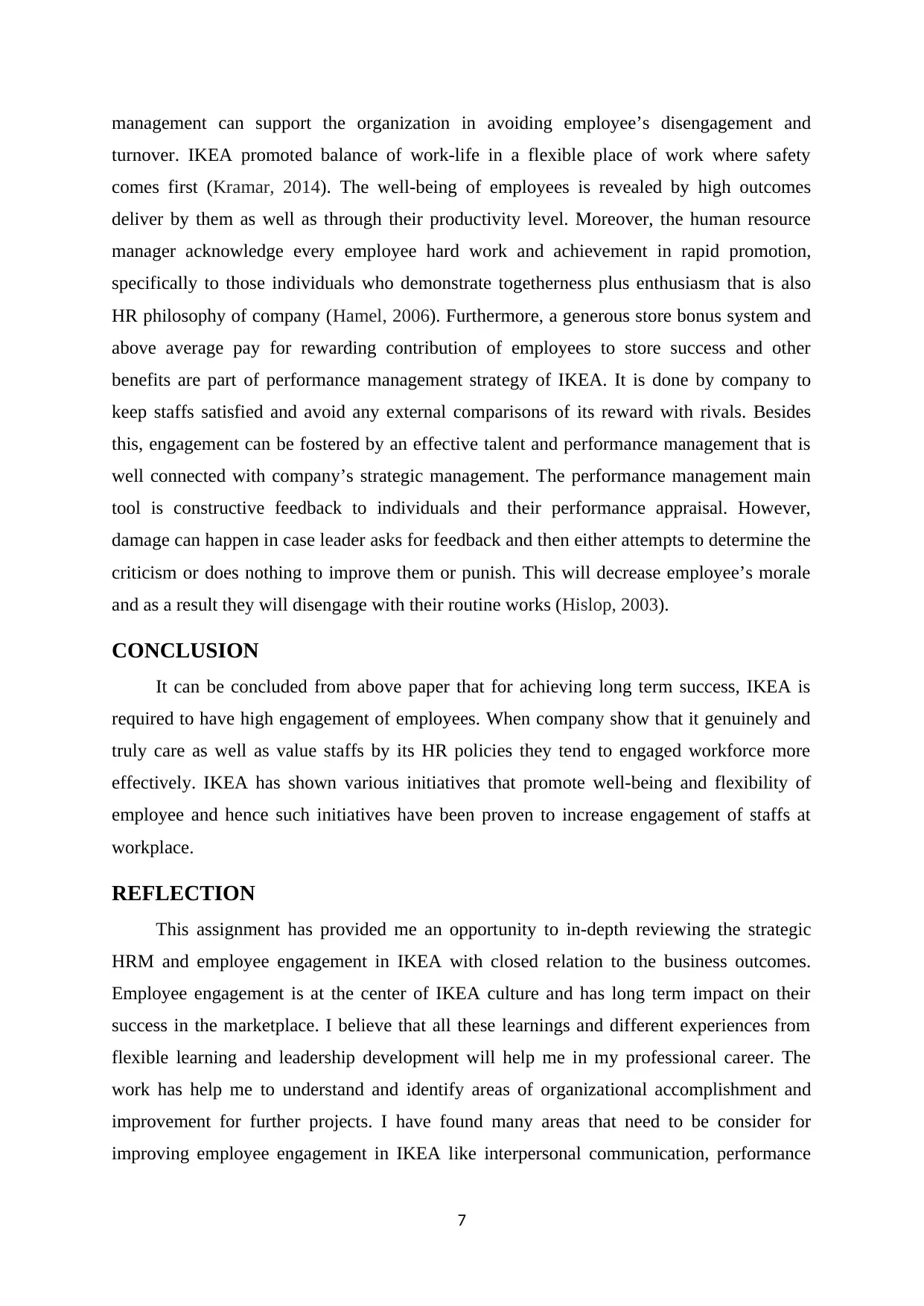
management can support the organization in avoiding employee’s disengagement and
turnover. IKEA promoted balance of work-life in a flexible place of work where safety
comes first (Kramar, 2014). The well-being of employees is revealed by high outcomes
deliver by them as well as through their productivity level. Moreover, the human resource
manager acknowledge every employee hard work and achievement in rapid promotion,
specifically to those individuals who demonstrate togetherness plus enthusiasm that is also
HR philosophy of company (Hamel, 2006). Furthermore, a generous store bonus system and
above average pay for rewarding contribution of employees to store success and other
benefits are part of performance management strategy of IKEA. It is done by company to
keep staffs satisfied and avoid any external comparisons of its reward with rivals. Besides
this, engagement can be fostered by an effective talent and performance management that is
well connected with company’s strategic management. The performance management main
tool is constructive feedback to individuals and their performance appraisal. However,
damage can happen in case leader asks for feedback and then either attempts to determine the
criticism or does nothing to improve them or punish. This will decrease employee’s morale
and as a result they will disengage with their routine works (Hislop, 2003).
CONCLUSION
It can be concluded from above paper that for achieving long term success, IKEA is
required to have high engagement of employees. When company show that it genuinely and
truly care as well as value staffs by its HR policies they tend to engaged workforce more
effectively. IKEA has shown various initiatives that promote well-being and flexibility of
employee and hence such initiatives have been proven to increase engagement of staffs at
workplace.
REFLECTION
This assignment has provided me an opportunity to in-depth reviewing the strategic
HRM and employee engagement in IKEA with closed relation to the business outcomes.
Employee engagement is at the center of IKEA culture and has long term impact on their
success in the marketplace. I believe that all these learnings and different experiences from
flexible learning and leadership development will help me in my professional career. The
work has help me to understand and identify areas of organizational accomplishment and
improvement for further projects. I have found many areas that need to be consider for
improving employee engagement in IKEA like interpersonal communication, performance
7
turnover. IKEA promoted balance of work-life in a flexible place of work where safety
comes first (Kramar, 2014). The well-being of employees is revealed by high outcomes
deliver by them as well as through their productivity level. Moreover, the human resource
manager acknowledge every employee hard work and achievement in rapid promotion,
specifically to those individuals who demonstrate togetherness plus enthusiasm that is also
HR philosophy of company (Hamel, 2006). Furthermore, a generous store bonus system and
above average pay for rewarding contribution of employees to store success and other
benefits are part of performance management strategy of IKEA. It is done by company to
keep staffs satisfied and avoid any external comparisons of its reward with rivals. Besides
this, engagement can be fostered by an effective talent and performance management that is
well connected with company’s strategic management. The performance management main
tool is constructive feedback to individuals and their performance appraisal. However,
damage can happen in case leader asks for feedback and then either attempts to determine the
criticism or does nothing to improve them or punish. This will decrease employee’s morale
and as a result they will disengage with their routine works (Hislop, 2003).
CONCLUSION
It can be concluded from above paper that for achieving long term success, IKEA is
required to have high engagement of employees. When company show that it genuinely and
truly care as well as value staffs by its HR policies they tend to engaged workforce more
effectively. IKEA has shown various initiatives that promote well-being and flexibility of
employee and hence such initiatives have been proven to increase engagement of staffs at
workplace.
REFLECTION
This assignment has provided me an opportunity to in-depth reviewing the strategic
HRM and employee engagement in IKEA with closed relation to the business outcomes.
Employee engagement is at the center of IKEA culture and has long term impact on their
success in the marketplace. I believe that all these learnings and different experiences from
flexible learning and leadership development will help me in my professional career. The
work has help me to understand and identify areas of organizational accomplishment and
improvement for further projects. I have found many areas that need to be consider for
improving employee engagement in IKEA like interpersonal communication, performance
7
⊘ This is a preview!⊘
Do you want full access?
Subscribe today to unlock all pages.

Trusted by 1+ million students worldwide
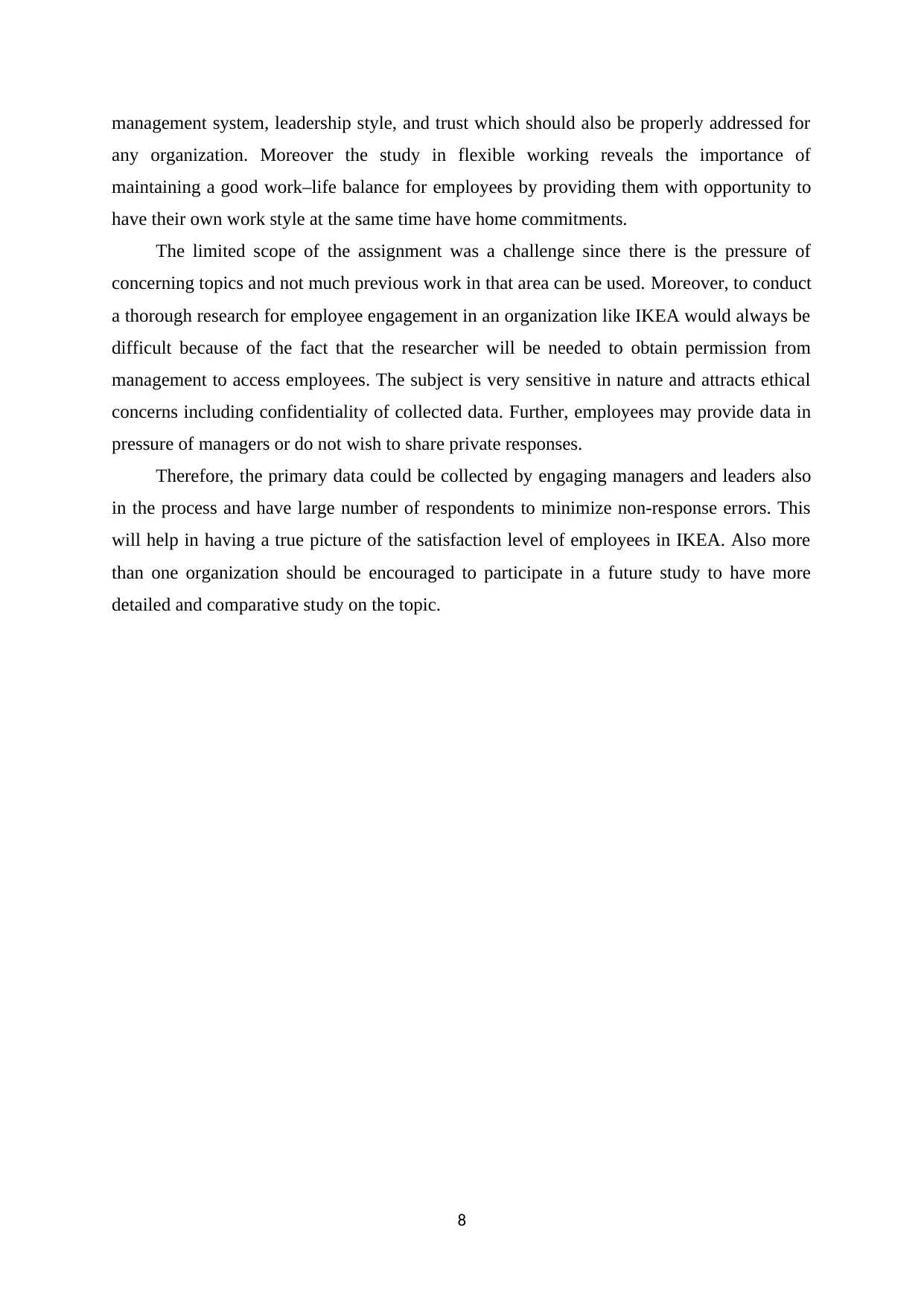
management system, leadership style, and trust which should also be properly addressed for
any organization. Moreover the study in flexible working reveals the importance of
maintaining a good work–life balance for employees by providing them with opportunity to
have their own work style at the same time have home commitments.
The limited scope of the assignment was a challenge since there is the pressure of
concerning topics and not much previous work in that area can be used. Moreover, to conduct
a thorough research for employee engagement in an organization like IKEA would always be
difficult because of the fact that the researcher will be needed to obtain permission from
management to access employees. The subject is very sensitive in nature and attracts ethical
concerns including confidentiality of collected data. Further, employees may provide data in
pressure of managers or do not wish to share private responses.
Therefore, the primary data could be collected by engaging managers and leaders also
in the process and have large number of respondents to minimize non-response errors. This
will help in having a true picture of the satisfaction level of employees in IKEA. Also more
than one organization should be encouraged to participate in a future study to have more
detailed and comparative study on the topic.
8
any organization. Moreover the study in flexible working reveals the importance of
maintaining a good work–life balance for employees by providing them with opportunity to
have their own work style at the same time have home commitments.
The limited scope of the assignment was a challenge since there is the pressure of
concerning topics and not much previous work in that area can be used. Moreover, to conduct
a thorough research for employee engagement in an organization like IKEA would always be
difficult because of the fact that the researcher will be needed to obtain permission from
management to access employees. The subject is very sensitive in nature and attracts ethical
concerns including confidentiality of collected data. Further, employees may provide data in
pressure of managers or do not wish to share private responses.
Therefore, the primary data could be collected by engaging managers and leaders also
in the process and have large number of respondents to minimize non-response errors. This
will help in having a true picture of the satisfaction level of employees in IKEA. Also more
than one organization should be encouraged to participate in a future study to have more
detailed and comparative study on the topic.
8
Paraphrase This Document
Need a fresh take? Get an instant paraphrase of this document with our AI Paraphraser
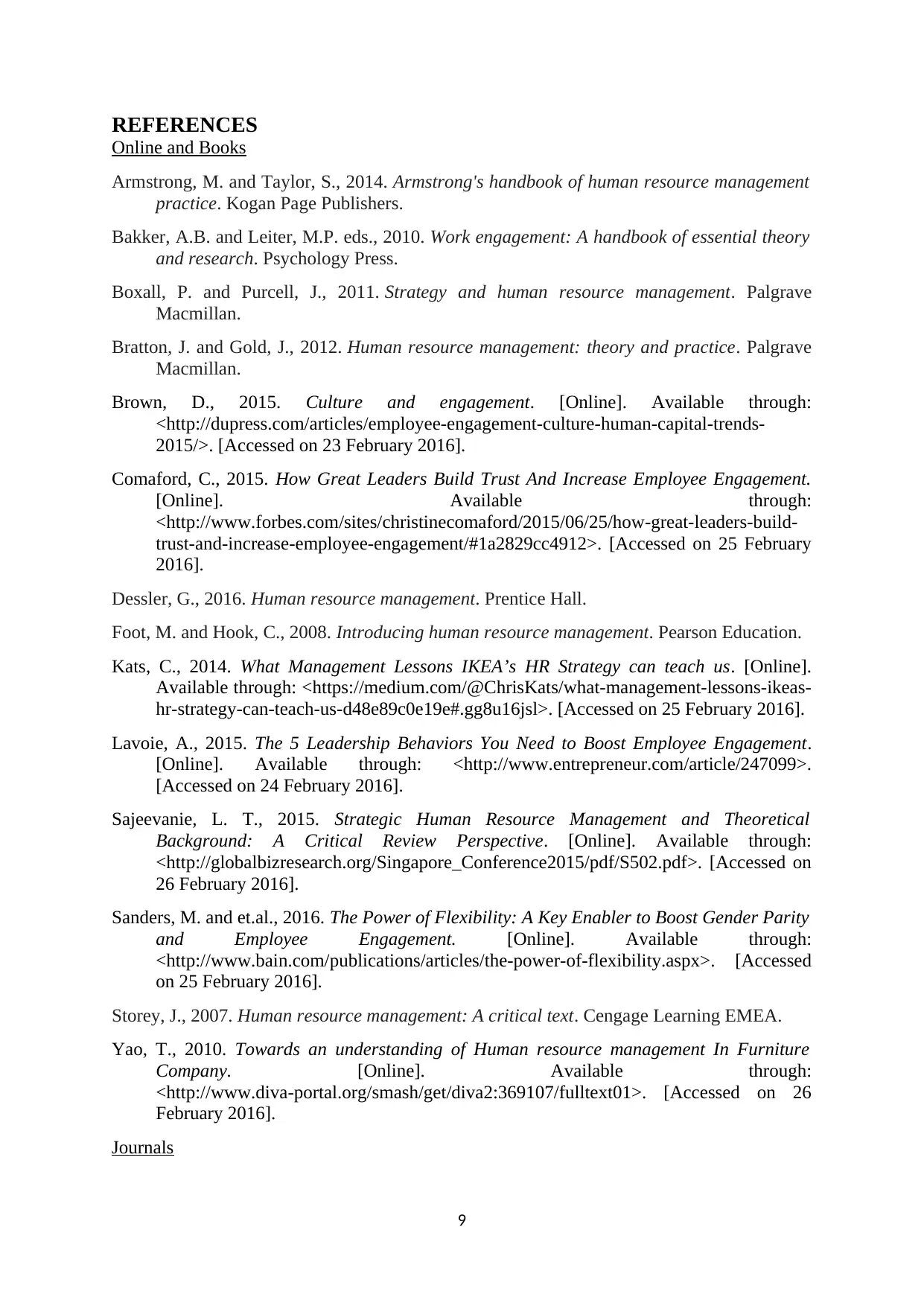
REFERENCES
Online and Books
Armstrong, M. and Taylor, S., 2014. Armstrong's handbook of human resource management
practice. Kogan Page Publishers.
Bakker, A.B. and Leiter, M.P. eds., 2010. Work engagement: A handbook of essential theory
and research. Psychology Press.
Boxall, P. and Purcell, J., 2011. Strategy and human resource management. Palgrave
Macmillan.
Bratton, J. and Gold, J., 2012. Human resource management: theory and practice. Palgrave
Macmillan.
Brown, D., 2015. Culture and engagement. [Online]. Available through:
<http://dupress.com/articles/employee-engagement-culture-human-capital-trends-
2015/>. [Accessed on 23 February 2016].
Comaford, C., 2015. How Great Leaders Build Trust And Increase Employee Engagement.
[Online]. Available through:
<http://www.forbes.com/sites/christinecomaford/2015/06/25/how-great-leaders-build-
trust-and-increase-employee-engagement/#1a2829cc4912>. [Accessed on 25 February
2016].
Dessler, G., 2016. Human resource management. Prentice Hall.
Foot, M. and Hook, C., 2008. Introducing human resource management. Pearson Education.
Kats, C., 2014. What Management Lessons IKEA’s HR Strategy can teach us. [Online].
Available through: <https://medium.com/@ChrisKats/what-management-lessons-ikeas-
hr-strategy-can-teach-us-d48e89c0e19e#.gg8u16jsl>. [Accessed on 25 February 2016].
Lavoie, A., 2015. The 5 Leadership Behaviors You Need to Boost Employee Engagement.
[Online]. Available through: <http://www.entrepreneur.com/article/247099>.
[Accessed on 24 February 2016].
Sajeevanie, L. T., 2015. Strategic Human Resource Management and Theoretical
Background: A Critical Review Perspective. [Online]. Available through:
<http://globalbizresearch.org/Singapore_Conference2015/pdf/S502.pdf>. [Accessed on
26 February 2016].
Sanders, M. and et.al., 2016. The Power of Flexibility: A Key Enabler to Boost Gender Parity
and Employee Engagement. [Online]. Available through:
<http://www.bain.com/publications/articles/the-power-of-flexibility.aspx>. [Accessed
on 25 February 2016].
Storey, J., 2007. Human resource management: A critical text. Cengage Learning EMEA.
Yao, T., 2010. Towards an understanding of Human resource management In Furniture
Company. [Online]. Available through:
<http://www.diva-portal.org/smash/get/diva2:369107/fulltext01>. [Accessed on 26
February 2016].
Journals
9
Online and Books
Armstrong, M. and Taylor, S., 2014. Armstrong's handbook of human resource management
practice. Kogan Page Publishers.
Bakker, A.B. and Leiter, M.P. eds., 2010. Work engagement: A handbook of essential theory
and research. Psychology Press.
Boxall, P. and Purcell, J., 2011. Strategy and human resource management. Palgrave
Macmillan.
Bratton, J. and Gold, J., 2012. Human resource management: theory and practice. Palgrave
Macmillan.
Brown, D., 2015. Culture and engagement. [Online]. Available through:
<http://dupress.com/articles/employee-engagement-culture-human-capital-trends-
2015/>. [Accessed on 23 February 2016].
Comaford, C., 2015. How Great Leaders Build Trust And Increase Employee Engagement.
[Online]. Available through:
<http://www.forbes.com/sites/christinecomaford/2015/06/25/how-great-leaders-build-
trust-and-increase-employee-engagement/#1a2829cc4912>. [Accessed on 25 February
2016].
Dessler, G., 2016. Human resource management. Prentice Hall.
Foot, M. and Hook, C., 2008. Introducing human resource management. Pearson Education.
Kats, C., 2014. What Management Lessons IKEA’s HR Strategy can teach us. [Online].
Available through: <https://medium.com/@ChrisKats/what-management-lessons-ikeas-
hr-strategy-can-teach-us-d48e89c0e19e#.gg8u16jsl>. [Accessed on 25 February 2016].
Lavoie, A., 2015. The 5 Leadership Behaviors You Need to Boost Employee Engagement.
[Online]. Available through: <http://www.entrepreneur.com/article/247099>.
[Accessed on 24 February 2016].
Sajeevanie, L. T., 2015. Strategic Human Resource Management and Theoretical
Background: A Critical Review Perspective. [Online]. Available through:
<http://globalbizresearch.org/Singapore_Conference2015/pdf/S502.pdf>. [Accessed on
26 February 2016].
Sanders, M. and et.al., 2016. The Power of Flexibility: A Key Enabler to Boost Gender Parity
and Employee Engagement. [Online]. Available through:
<http://www.bain.com/publications/articles/the-power-of-flexibility.aspx>. [Accessed
on 25 February 2016].
Storey, J., 2007. Human resource management: A critical text. Cengage Learning EMEA.
Yao, T., 2010. Towards an understanding of Human resource management In Furniture
Company. [Online]. Available through:
<http://www.diva-portal.org/smash/get/diva2:369107/fulltext01>. [Accessed on 26
February 2016].
Journals
9
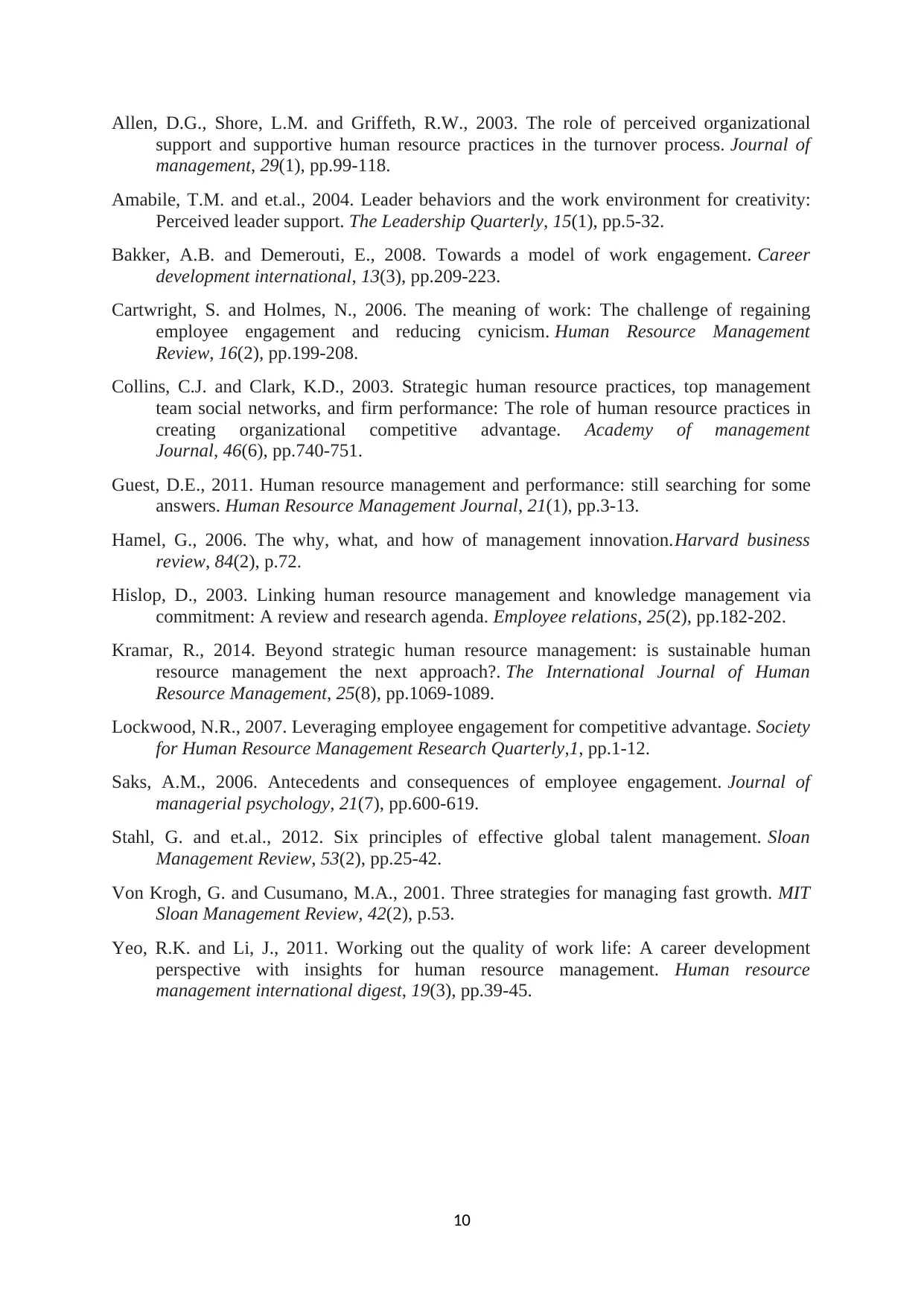
Allen, D.G., Shore, L.M. and Griffeth, R.W., 2003. The role of perceived organizational
support and supportive human resource practices in the turnover process. Journal of
management, 29(1), pp.99-118.
Amabile, T.M. and et.al., 2004. Leader behaviors and the work environment for creativity:
Perceived leader support. The Leadership Quarterly, 15(1), pp.5-32.
Bakker, A.B. and Demerouti, E., 2008. Towards a model of work engagement. Career
development international, 13(3), pp.209-223.
Cartwright, S. and Holmes, N., 2006. The meaning of work: The challenge of regaining
employee engagement and reducing cynicism. Human Resource Management
Review, 16(2), pp.199-208.
Collins, C.J. and Clark, K.D., 2003. Strategic human resource practices, top management
team social networks, and firm performance: The role of human resource practices in
creating organizational competitive advantage. Academy of management
Journal, 46(6), pp.740-751.
Guest, D.E., 2011. Human resource management and performance: still searching for some
answers. Human Resource Management Journal, 21(1), pp.3-13.
Hamel, G., 2006. The why, what, and how of management innovation.Harvard business
review, 84(2), p.72.
Hislop, D., 2003. Linking human resource management and knowledge management via
commitment: A review and research agenda. Employee relations, 25(2), pp.182-202.
Kramar, R., 2014. Beyond strategic human resource management: is sustainable human
resource management the next approach?. The International Journal of Human
Resource Management, 25(8), pp.1069-1089.
Lockwood, N.R., 2007. Leveraging employee engagement for competitive advantage. Society
for Human Resource Management Research Quarterly,1, pp.1-12.
Saks, A.M., 2006. Antecedents and consequences of employee engagement. Journal of
managerial psychology, 21(7), pp.600-619.
Stahl, G. and et.al., 2012. Six principles of effective global talent management. Sloan
Management Review, 53(2), pp.25-42.
Von Krogh, G. and Cusumano, M.A., 2001. Three strategies for managing fast growth. MIT
Sloan Management Review, 42(2), p.53.
Yeo, R.K. and Li, J., 2011. Working out the quality of work life: A career development
perspective with insights for human resource management. Human resource
management international digest, 19(3), pp.39-45.
10
support and supportive human resource practices in the turnover process. Journal of
management, 29(1), pp.99-118.
Amabile, T.M. and et.al., 2004. Leader behaviors and the work environment for creativity:
Perceived leader support. The Leadership Quarterly, 15(1), pp.5-32.
Bakker, A.B. and Demerouti, E., 2008. Towards a model of work engagement. Career
development international, 13(3), pp.209-223.
Cartwright, S. and Holmes, N., 2006. The meaning of work: The challenge of regaining
employee engagement and reducing cynicism. Human Resource Management
Review, 16(2), pp.199-208.
Collins, C.J. and Clark, K.D., 2003. Strategic human resource practices, top management
team social networks, and firm performance: The role of human resource practices in
creating organizational competitive advantage. Academy of management
Journal, 46(6), pp.740-751.
Guest, D.E., 2011. Human resource management and performance: still searching for some
answers. Human Resource Management Journal, 21(1), pp.3-13.
Hamel, G., 2006. The why, what, and how of management innovation.Harvard business
review, 84(2), p.72.
Hislop, D., 2003. Linking human resource management and knowledge management via
commitment: A review and research agenda. Employee relations, 25(2), pp.182-202.
Kramar, R., 2014. Beyond strategic human resource management: is sustainable human
resource management the next approach?. The International Journal of Human
Resource Management, 25(8), pp.1069-1089.
Lockwood, N.R., 2007. Leveraging employee engagement for competitive advantage. Society
for Human Resource Management Research Quarterly,1, pp.1-12.
Saks, A.M., 2006. Antecedents and consequences of employee engagement. Journal of
managerial psychology, 21(7), pp.600-619.
Stahl, G. and et.al., 2012. Six principles of effective global talent management. Sloan
Management Review, 53(2), pp.25-42.
Von Krogh, G. and Cusumano, M.A., 2001. Three strategies for managing fast growth. MIT
Sloan Management Review, 42(2), p.53.
Yeo, R.K. and Li, J., 2011. Working out the quality of work life: A career development
perspective with insights for human resource management. Human resource
management international digest, 19(3), pp.39-45.
10
⊘ This is a preview!⊘
Do you want full access?
Subscribe today to unlock all pages.

Trusted by 1+ million students worldwide
1 out of 12
Related Documents
Your All-in-One AI-Powered Toolkit for Academic Success.
+13062052269
info@desklib.com
Available 24*7 on WhatsApp / Email
![[object Object]](/_next/static/media/star-bottom.7253800d.svg)
Unlock your academic potential
Copyright © 2020–2025 A2Z Services. All Rights Reserved. Developed and managed by ZUCOL.





